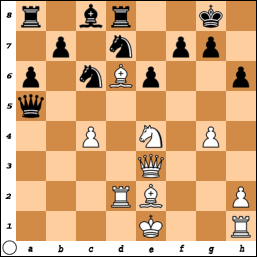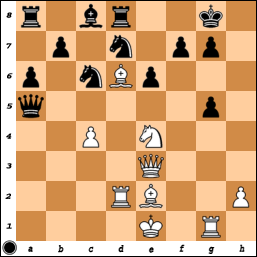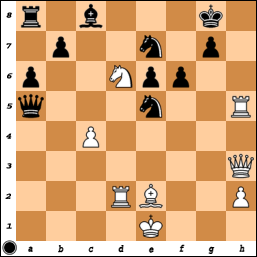The Poisoned Pawn variation of the Najdorf is one of the most theoretically dense variations in modern chess. Negi gave plenty of ideas against it in 1.e4 vs The Sicilian I. But would players remember the theory? And would the ideas work?
Yes and yes. Obviously.
Jorden van Foreest (2494) – Nico Zwirs (2358)
Amsterdam 20.02.2015
1.e4 c5 2.Nf3 d6 3.d4 cxd4 4.Nxd4 Nf6 5.Nc3 a6 6.Bg5 e6 7.f4 Qb6 8.Qd2 Qxb2 9.Rb1 Qa3 10.e5 dxe5 11.fxe5 Nfd7 12.Ne4 h6 13.Bh4 Qxa2 14.Rd1 Qd5 15.Qe3 Qxe5 16.Be2 Bc5 17.Bg3 Qd5 18.c4 Bxd4 19.Rxd4 Qa5+ 20.Rd2 0–0 21.Bd6 Rd8 22.g4 Nc6
All Negi. It’s on page 255 of the book if you wish to check.

23.g5!?
This move was a novelty when Negi suggested it, and 15-year-old Dutch IM Jorden van Foreest is the first to test it. In Negi’s words, this move is “the maximalist try”.
Negi’s main line is 23.0–0!? which is “the simplest way, which does not require too much analysis.”
23…hxg5 24.Rg1

24…Nde5
Finally leaving the book. The line Negi gave was 24…f6 25.h4 Nde5 26.hxg5 f5 27.Nf6+ Kf7 28.c5 ‘with compensation’. This line shows one benefit of having an immensely strong player writing the book, as an engine would not guide a lesser player towards this line. For most of the line the machine is saying Black is much better, but in the final position, after a while, it begins to see the danger.
25.Rxg5 Rxd6
Sacrificing the exchange is a good thematic try.
26.Nxd6 f6 27.Rh5!
The threats on the h-file are extremely strong. I would have been tempted to keep firing on the g-file with 27.Rg1!? which should also work.
27…Ne7?!
Now White breaks through directly. 27…f5 was a stouter defence, but White has various good replies, including 28.Qg3!? switching the focus back to the g-file.
28.Qh3!+–

28…N7g6 29.Nxc8 Nf4
29…Rxc8 30.Qxe6+ is of course hopeless.
29…f5 was a try, hoping that White misses 30.Ne7+! but the way White played this game, one can be sure he would not have missed this decoying blow.
30.Rh8+ Kf7 31.Bh5+ Neg6
31…g6 32.Bxg6+! would be mate in just two more moves.
32.Bxg6+ Nxg6 33.Nd6+ Ke7 34.Rxa8
The material count is two rooks against three pawns.
34…Qe5+ 35.Re2 Qa1+
35…Qxe2+ 36.Kxe2 Nf4+ 37.Ke3 Nxh3 wins back a rook, but that still leaves Black one rook down. In an ending.
36.Kf2 Qd4+ 37.Kf1 Qf4+ 38.Kg2 Qxd6 39.Rxe6+! Qxe6 40.Re8+ Kf7
A funnier exit than resigning.
41.Qxe6#
An impressive game by the young Dutch player.
Basically Van Foreest played 4 moves in this game, impressive… 🙂
@Jonathan Faydi
Four moves on his own before he had a winning position. But then he had to win his winning position. Anyway, I was impressed!
Negi’s 2nd volume. page 208/209.
after 10.g4, i cant see any reccomendations for 10…Rb8? i know every line cant be written, but a few ideas are wellcome for me, even here.
@Hilmi M
I might have time for a look over the weekend. It seems to be a very rare line, so new ideas for White should be lurking.
What’s next for Negi? Sicilian II? Or 1…e5?
I’m absolutely loving both books so far. I hope he keeps up publishing a new one every 5-6 months or so, but that must be extremely difficult to do.
@Seth
3rd is for rest of the sicilians, 4th is for the spanish, and the last one is for the minor openings against e4; if i remember true. but i am sure about the 3rd, it s written somewhere at the blog.
@Hilmi M
Thank you!
@Hilmi M
In my memory the volume on the Spanish is the last one.
I did have some ideas in that line. I may have to turn it into a post, because it would be a long and involved comment. Maybe later this week.
well i am an ameteur player, and i feel sorry to have your time for this only. i have looked few games.
thank you anyway.
@John Shaw
@Hilmi M
No problem. I looked at it over lunch a few times for fun. So no work time was lost!
Speaking of Negi novelties (that’s fun to say out loud), Irina Krush played 10…0-0 vs Negi’s 10.Bd3 line of the 7…a6 Classical French in day two of round 1 vs Sophie Milliet of France.
I wonder if that was prep or not, as the Greek Sacrifice became very tempting either right on move 11 or over the course of the next few moves.
chess is getting a memory game…
@gewgaw
Actually it is more the opposite. Where have you been the last five years??
@Jacob Aagaard
🙂 I think it’s best to see the GM Rep books (and also Kotronias’s series on the KID) as middle game books.
A question for all Najdorf fans:
What is the most practical response to 6.Bg5.
I have used the poisoned pawn quite a lot but the amount of theory really start to be too extensive. Also there are lots of forced draws. This is also the problem with the Gelfand variation.
My suggestion is that 6.-e6 7.f4, Be7 8.Qf3, Qc7 9.0-0-0, Nbd7 might be the most practical.
I am not aware of any easy forced draw here. Also what is the current verdict of the blood diamond variation?
@Bebbe
I agree with your suggestion – the ‘Old main line’ is not bad at all i.m.o. and indeed there are not many forced draws.
@Ray
The critical variations seems to be 10.f5 and 10.g4, b5 11.Bxf6, Nxf6 12.g5, Nd7 13.f5, Bxg5+ 14.Kb1, Ne5 15.Qh5, Qe7 16.Nxe6, Bxe6 17.fxe6, g6 18. exf7+, Kxf7 19.Qe2, Kg7 20. Nd5, Qd8. How is this position?
10. Be2 and 10. Qg3 are toothless and 10.Bd3, h6 11.Bh4, g5 12.fxg5, Ne5 13.Qe2, Nfg4 seems OK for black, see GM repertoire 6.
The piece sacrifice 13.Nf5 is also dangerous after 10.g4, b5 11.Bxf6, Nxf6 12.g5, Nd7.
@Bebbe
I don’t know about the current status of theory to be honest – it’s been a few years since I last looked at this (I quit trying to play the Najdorf). But back then I had a little book by Rizzitano by Gambit and the lines he gave were all ok for black. But maybe theory has moved on since then (though this line hasn’t been popular for years – I don’t really underrstand why to be honest).
@Ray
No I dont understand this either. None of the super-GMs seems to play it anymore.
It seems that they know something that the rest of us dont. Hovever I cant figure it out.
The key positions seems playable. Or maybe it is such a shallow thing as fashion?!
I had a look at 6.Bg5, Nbd7 and it seems to be a very combative line. Real fighting chess with lots of decisive results! I hope that GM repertoire 6b will contain an update on this. A lot has really happened since GM6 was published.